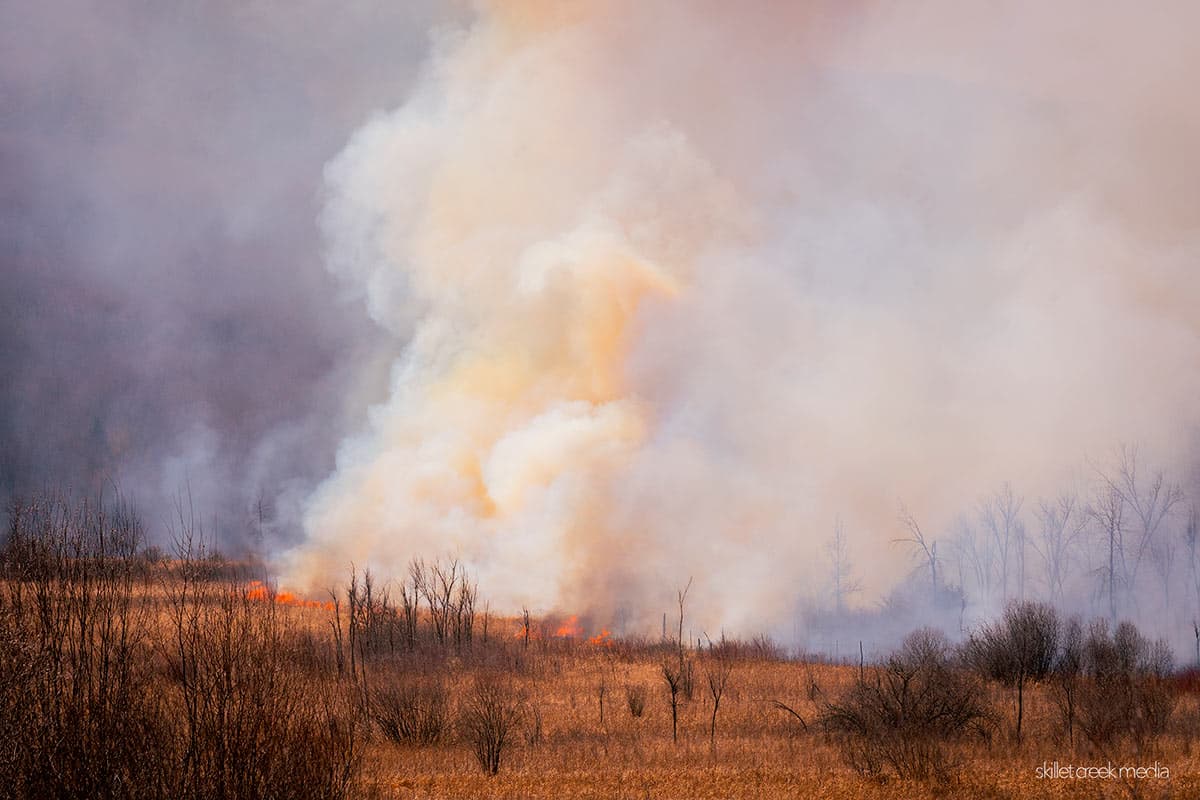Yesterday, March 18th, a prescribed burn was carried out on Devil's Lake State Park's Roznos…

As you’re out hiking the trails right now, you’ll notice a lot of green is showing up! Awesome, right?! Well, did you know that much of the green you’re seeing around Devil’s Lake State Park this early in the spring is invasive? Yup! Let’s have a look!
Garlic Mustard
So, that photo above shows all the garlic mustard sprouting up along the Uplands Trail on the east side of the park. I’m sure you’ve heard all about garlic mustard before, but the main thing that makes it evil is that it will crowd out all of the native plants that grow on the forest floor. What’s more, garlic mustard actually produces a toxin that kills soil fungi many plants depend on. Flowers, food for wildlife, etc., all go away when garlic mustard moves in. Right now, garlic mustard accounts for most of the green you’re seeing on the ground along the trails.
Bush Honeysuckle

When you look into the forests as you hike, you’ll likely see lots of slightly yellowish brush with green buds and leaves just coming out. In some regions of Devil’s Lake State Park, it fills the forest. This is another invasive plant called Bush Honeysuckle. Seas of honeysuckle move through the forests and wetlands engulfing and drownding out native trees and plants. They literally are choking the beauty of the park’s forests in many areas.

The Early Bird!
You know the saying, “The early bird gets the worm!”. Well, this is one of the reasons these invaders are winning the war against our native plants. They are going green early, getting their leaves out and sucking up the energy before our local plants. Then by the time Wisconsin’s native flowers and shrubs start to grow, they struggle to get nutrients and even sunlight! That sucks! Especially when we’re looking forward to seeing lots of spring flowers in just a few weeks. We’d certainly see a lot more if we could do something about these invaders!
The Solution?
Nothing is easy. It’s actually pretty hard to control garlic mustard or bush honeysuckle. Garlic mustard can be burned and sprayed, but that’s hard to do since they grow along with native plants. The best solution is just to pull them before they seed. You’ll often see volunteer days each year when we get out to pull garlic mustard. Many hikers, will just pull it on their own. That’s cool, (And Thank YOU!) but here’s the important thing; BAG IT AND THROW IT AWAY! You don’t want to leave garlic mustard on the trail because even after it’s pulled the seeds will mature and the plant will spread! It’s a zombie plant!

Bush Honeysuckle is nasty as well. If you cut it, it will just grow right back! So when you do cut them down, you have to daub the stumps with poison to stop them from regrowing. The only other option is to rip them out of the ground, roots and all! I’ve done that. It’s hard work!! If you hike out along the Steinke Basin Trail, you’ll see the results of one volunteer whos’s been cutting out honeysuckle on his own for a couple of years now.
Spring Beauty!

Where these invasives have not taken over, you can see the beginning Wisconsin’s native spring flower show starting to appear this week. At Devil’s Lake among the rocks we can see the leaves of Dutchman’s Breeches which means their chains of white flowers will soon be blooming. You’ll also see tiny white and purple flowers dotting the forests. Chances are these are hepatica or spring beauty. You may also see the white flowers of some early bloodroot plants as well.


For nearly 2 decades the Skillet Creek blog has focused on 3 main goals; To inspire you to visit and explore the Devil’s Lake region, to help you get the most your visit by sharing tips, events, and other helpful information. Lastly to advocate for our environment & wildlife and talk about how we can keep our natural areas amazing now and into the future! That last goal can sometimes cause controversy, but it’s the only way we can accomplish the first two. – Derrick Mayoleth, Owner.



